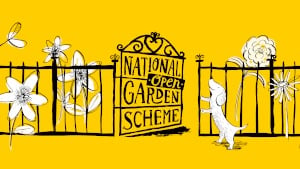About Ferns Lodge
Ferns Lodge garden is home to a plethora of wildlife from bat, to fox, to badger to toad, and birds abound. Totally natural, you will find no sprays or weed killers here to disturb them in their home.
The Lodge house is surrounded by a half acre cottage garden which has been landscaped with brick paths, a handsome terrace, gazebo and lovely double baked brick paths. The bottom barn has a sedum roof and there is a very pretty summer house – in active use as an office. The planting is traditional and a riff on what does well – iris, foxglove hydrangea, fig, rhododendron, azalea, salvia, tree fern and camelia. Poppies, and sweet peas abound and of roses there are many.
Beyond the cottage garden gates lie 3½ acres of Victorian garden that lay slumbering and seen only by the badger, bats and weasels for over 50 years until it was added to the garden in 2012. With a perimeter of English oaks, and a circle of holm oaks as well as a collection of mighty monterey pines which are home to a treehouse, progress is slow but delightful. Peeling back the laurel and briars, and clearing away some builders’ rubbish from many years ago, there have been many delightful surprises, the best of which is definitely the cork oak which is now starting to thrive with light and air.
Once a formal garden, it is now much more informal and is morphing into a charming woodland garden full of habitat areas and fallen trunks left to create food and homes for the wildlife that lives there. Our bees are doing a terrific job to pollinate and bring this old garden back to life. It is all about light touch and hanging onto the tranquillity of this lovely old place. 2020 saw a clearance in the bottom meadow and new planting as a precursor for a woodland walk through the centre of the garden.
A massive job has been the creation of a new vegetable garden, now taking shape. There is now a large vegetable and fruit area, covered against the throng of wildlife that share this place, a poly tunnel and Dan’s Wall – a ruined wall that formed part of the greenhouses built for the Victorians who gardened here long before us. 2023 saw the building of a Woodpecker red cedar greenhouse in the style of the original Messanger Victorian greenhouses. To go with it is a new 4,500 litre sweet water tank sunk into the ground beneath to nourish the planting. There is still much to do and 2 new shrubberies cleared and planted in 2022 and 2023 are starting to establish from ruin of past gardeners – we have a head start with 2 amazing tree rhododendrons planted over 100 years ago. We lost one of our ring of mighty holm oaks in the spring of 2023 so a new circle has been planted to take over in the far future.
We are looking forward to opening in 2024 and we hope that you will enjoy the peace and tranquillity of this secret garden at the bottom of a small and winding lane. The winter projects we hope will be completed before your visit and you will see just a little more of what the place will one day become.
Kick back, relax and breathe – and the garden will breathe with you. Whilst you are with us, please venture to the top garden to try some of our delicious home-made scones and a cup of rather good tea – or more should you wish. All baked by the Ferns Lodge team, with care, for your enjoyment.
Private visits are so very welcome from May to June in the early evening in the cool of the day with nibbles, wine, beer and soft drinks for the drivers amongst us. There is a restriction on 5 cars, not people.
.
Website:
https://www.fernslodge.co.uk
.jpg)
.jpg)
.jpg)
.jpg)
.jpg)
.jpg)
.jpg)
.jpg)
.jpg)
.jpg)
.jpg)
.jpg)
.jpg)
.jpg)
.jpg)
.jpg)
.jpg)
.jpg)


.jpg)
.jpg)

.jpg)